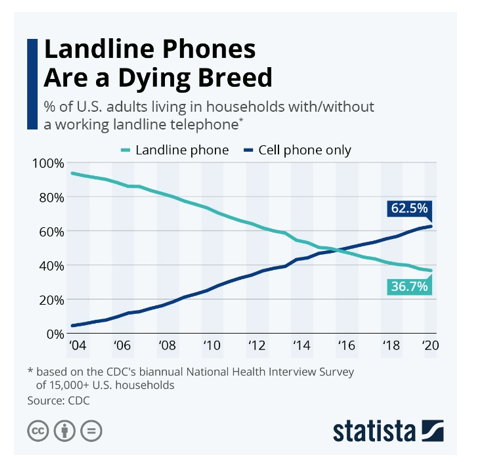Plain Old Telephony Service (POTS) - the traditional copper wire network that has been around since the 1880s - is no longer going to be supported by the major phone carriers in the U.S.
Most carriers have moved on to newer technologies, such as fiber optics and mobile/cellular, and no longer need or want to support outdated network infrastructure.
How will this affect YOUR organization? It's time to switch to a cloud-based voice system like Microsoft 365 Business Voice.
But, a quick background first!
Why Are Copper Phone Lines Being Phased Out?
In response to a 2010 order from the Federal Communications Commission (FCC) that mandates all POTS lines in the US be replaced with an alternative service by August 2, 2022, major carriers like Verizon and AT&T have been dropping support for these copper-based lines as well as raising prices for POTS service dramatically – sometimes doubling or tripling per-line costs.
While it may not be a surprise to learn POTS use has declined, the numbers are still staggering: By 2015, over half of American households had gone wireless-only.
 Carriers had long been frustrated by having to maintain increasingly expensive copper phone lines (and telephone pole infrastructure) for a dwindling number of customers, all for the sake of fulfilling its “universal service” regulatory obligations.
Carriers had long been frustrated by having to maintain increasingly expensive copper phone lines (and telephone pole infrastructure) for a dwindling number of customers, all for the sake of fulfilling its “universal service” regulatory obligations.
Once the requirement to support POTS is dropped, the dominoes will fall even faster, with carriers diverting resources away from traditional phone lines and toward more popular (and profitable) offerings.
The end result will eventually be the complete decommissioning of copper phone lines.
So let’s look at the services this decision affects—and how that can impact your business.
What Services Are Being Impacted by Copper Phone Lines Going Away?
The phasing out of copper phone lines impacts several systems. Learn more about which services are being affected by copper phone lines being phased out below.
POTS (Plain Old Telephone Service)
Considered the standard for residential use, the POTS line was also critical for commercial businesses in several ways.
- Due to its Five-Nines reliability, POTS lines were required for elevators, fire and burglar alarm systems, Point of Sale, red phones and Voice over Internet Protocol (VoIP) backup.
- POTS lines were also the backbone of fax machines (which are still in use in many business environments).
Even years after a successful shift to Voice over IP (VoIP), many companies still rely on POTS for many of their legacy and safety devices.
So, what should you do about the copper phone line decommissioning?
Fortunately, because the writing has been on the wall for a while, solutions have arisen that offer the same “Old Faithful” reliability of POTS.
Businesses will soon be required to replace their POTS lines with a wireless POTS replacement device. These devices use LTE cellular service with an Ethernet backup to connect to the associated service provider.
Not sure if you are still utilizing POTS?
One of the easiest places to start is to contact your phone provider to ask if your phone line is a VoIP line or a traditional analog phone line.
We also recommend doing an inventory of your POTS lines and associated devices they connect to. You don’t want the decommissioning to take place and oops—a system you thought was on VoIP is now down for the count.
PRI (Primary Rate Interface)
The other upcoming casualty is the Primary Rate Interface (PRI).
A PRI is a dedicated copper connection between a business and its telephone service provider. It’s used to connect an on-premises business phone system to the PSTN (Public Switch Telephone Network) for making and receiving external calls.
Just like the POTS line, weakening demand and the increased cost to support the antiquated technology are the driving forces behind its demise: Carriers are already increasing the monthly price of a PRI or are no longer renewing annual subscriptions.
What Should You Do Next?
With copper phone lines going away, organizations need to find alternative solutions to
traditional landline phones. Cloud-based phone systems are a popular alternative
because they’re easy to use and can scale to fit your business.
Ntiva Voice helps your organization make a seamless transition from a traditional
phone system, allowing you to keep existing numbers and enjoy the basic features
you’re familiar with. However, we also offer advanced features like call center
functionality and voicemail to email.
Alternatively, customers can convert their service to a newer technology called SIP (Session Initiated Protocol). This conversion will most likely be an expensive one due to the required upgrade of the on-premises phone system.
In most cases, migrating the voice services to a hosted cloud provider will be a better option.
SIP vs. Cloud Phone Services
With analog phone lines going away, you can choose between switching to a cloud
phone system or using SIP.
SIP lines use SIP trunks to connect you to a phone network. These trunks are
significantly cheaper than traditional phone lines, but monthly costs are still higher
than with cloud-based solutions.
SIP also has more restrictions in terms of lines and extensions since it’s essentially
connecting your phone line to the internet.
Cloud-based phone systems use the internet instead of a phone line to connect
callers. Unlike SIP phone systems, cloud systems don’t have limits that restrict how
many lines or extensions you can have.
Cloud phone systems are also an affordable solution for businesses — especially
larger operations that need more lines.
Benefits of Going Digital
Copper phone lines going away is an inconvenience for many people at the moment,
but there are long-term benefits of digital phone systems.
Digital phone lines are more reliable, and that constant uptime is crucial for
businesses. With no physical phone system, there’s not as much maintenance
required.
The features that digital phone systems add can increase productivity and make your
business more efficient. When you combine that increased productivity with cost
savings, it can make a notable difference in your bottom line.
You don’t have to keep physical phones around anymore, and you can even keep your
existing phone number when you make the switch to digital.
Is There a Deadline for Switching to Another VoIP Service?
As of Aug 2, 2022, companies were no longer required to support POTS lines. There
is no exact deadline for switching to an alternative source, but transitioning to a digital
phone system sooner rather than later can make the shift easier.
If it’s time to upgrade your phone systems, there’s no better time to make the switch to
a cloud-based phone system.
Summary
Technology changes, and while copper phone infrastructure may soon be in our rear-view mirror, we’re always here to help you master the exciting new digital road you’re on.
If you are an Ntiva client, please reach out to your Account Manager who can help you through this process!
Not yet on VoIP and want to learn more about hosted VoIP services? Check out the article below!
Want to learn more about Communications Management for your business? Learn more about Ntiva's Microsoft 365 Business Voice offerings!



.png?width=300&name=Ntiva%20Voice%20HERO(1).png)